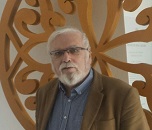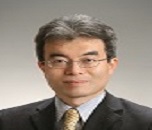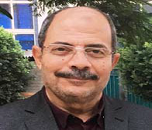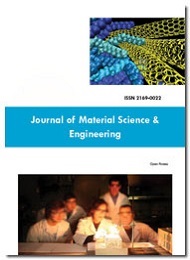Theme: Emerging Innovations and advancements in Materials science and Engineering
MATERIALS SCIENCE 2022
- About Conference
- Sessions/Tracks
- Participation / presentation option
- Abstract Submission Guidelines
- VISA requirements
- Market Analysis
Materials Science-2022 organizing committee invites the participants across the globe to attend the "35th International Conference on Material Science and Engineering : Advancement and Innovations" which is to be held April 04-05, 2022 Geneva, Switzerland.
Organized around the theme “Emerging Innovations and advancements in Materials science and Engineering” Materials Science-2022 is compared of various sessions to offer comprehensive and share new ideas Experts, industry and students from the fields of materials science, nanotechnology, chemistry and physics share their work experiences which provide prompt keynote presentations, oral presentations, poster competitions which exhibitions.
Materials Science-2022 delivers infinite occasions for creating business contracts produce enhancements, cutting authority resolutions for educating and inspiring company’s business and partnership. The conference affords a unique platform for all the important industrial professionals, institutional investors, industrialists, and commercial development executives to have reserved One-to-One meetings with elite business agents which escalations the probabilities of presentation in this interacting creation.
Why to Attend?
Materials Science-2022 offers a fantastic opportunity to meet and make new contacts in the field of Materials Science and Engineering by providing collaboration spaces and break-out rooms with tea and lunch for delegates between sessions with invaluable networking time for you. It allows delegates to have issues addressed on Materials Science by recognized global to experts who are up to date with the latest developments in the Materials Science field and provide information on new techniques and technologies. This international Materials Science conference will feature world renowned keynote speakers, plenary speeches, young research forum, poster presentations, technical workshops and carrier guidance sessions.
About City
Geneva is a city in Switzerland that lies at the southern tip of expansive Lac Leman (Lake Geneva). Surrounded by the Alps and Jura mountains, the city has views of dramatic Mont Blanc. Headquarters of Europe’s United Nations and the Red Cross, its a global hub for diplomacy and banking. French influence is widespread, from the language to gastronomy and bohemian districts like Carouge.
In 2021, Geneva was ranked as the world's ninth most important financial centre for competitiveness by the Global Financial Centers Index, fifth in Europe behind London, Zürich, Frankfurt and Luxembourg. In 2019, Geneva was ranked among the ten most livable cities in the world by Mercer together with Zürich and Basel. The city has been referred to as the world's most compact metropolis and the "Peace Capital". In 2019, Mercer ranked Geneva as the thirteenth most expensive city in the world. In a UBS ranking of global cities in 2018, Geneva was ranked first for gross earnings, second most expensive, and fourth in purchasing power.
Target Audience
Engineering professors and faculty.
Material science students.
Members of different material science associations.
Junior/Senior research fellows of Materials Science.
Scientists, Research Professors, Research Scholars and students.
Directors/Co-Directors of Research-based companies across the globe
Materials Scientists/Research Professors/Students
Track 1: Advances in Materials Science
Advances in Materials science are used for studying the relationship between structure, properties, and uses of materials. The themes are seen from international and interdisciplinary viewpoints covering areas with metals, ceramics, glasses, polymers, electrical materials, composite materials, nanostructured materials and biological and biomedical materials. It aims to be the important source of primary communication for scientists examining the structure and properties of all manufacturing materials. The advances that transformed all our daily lives and have completely changed the research arena are: The International Technology Roadmap for Semiconductors, Scanning probe microscopes, Giant magneto resistive effect, Semiconductor lasers and light-emitting diodes, National Nanotechnology Initiative, Carbon fiber reinforced plastics, Carbon nanotubes, Soft lithography and Metamaterials.
- assembling
- energy conservation
- facades
- fatigue property
- insulation material
- jig frame
- rapid construction
- sectional lifting
- steel truss
- stiffness degradation
- three-point bending
Track 2: Electrical, Optical, and Magnetic Materials
Materials which may be magnetized and interested in a magnet are termed as ferromagnetic materials. Magnetic Smart Materials even have medical applications and it's predictable that they're going to increase within the future. Magnetic Smart Materials even have medical applications and it's predictable that they're going to increase within the future. Now-a-days Scientists also are occupied on the advancement of synthetic magnetic particles which may be inoculated into the physical body for the diagnosis and treatment of disease. Spintronic, also referred to as spin electronics or Flextronics, is that the study of the intrinsic spin of the electron and its related moment of a magnet, additionally to its vital electronic charge, in solid-state devices.
- Organic Electronics
- Liquid Crystal Displays
- Optical Fibers
- An Overview of Photonic Systems
- Anisotropy and Domain Wall Energy
- Hard and Soft Magnetic Materials
- Optical and Magnetooptical Storage
Track 3: Advancement in Nanomaterials Science and Nanotechnology
Nanotechnology is the handling of matter on an atomic, molecular, and supramolecular scale. The interesting aspect of nanotechnology is that the properties of many materials alter when the size scale of their dimensions approaches nanometers. Materials scientists and engineers work to understand those property changes and utilize them in the processing and manufacture of materials at the Nano scale level. The field of materials science covers the discovery, characterization, properties, and use of Nano scale materials. Nanomaterial’s research takes a materials science-based approach to nanotechnology, influencing advances in materials metrology and synthesis which have been developed in support of micro fabrication research. Materials with structure at the Nano scale level o have unique optical, electronic, or mechanical properties. Although much of nanotechnology's potential still remains un-utilized, investment in the field is booming. The U.S. government distributed more than a billion dollars to nanotechnology research in 2005 to find new developments in nanotechnology. China, Japan and the European Union have spent similar amounts.
- colloid science
- nanophotonics
- Mechanical engineering
- Physics
Track 4: Materials for Green Technology
Green tech–or green technology–is an umbrella term that describes the use of technology and science to create products that are more environmentally friendly. Green technologies are utilized in the recycling of wastewater, generation of power through solar panels, wind turbines, and such other industries. Green Technology may be a non-profit initiative designed to tell government efforts toward sustainability, providing a forum during which officialdom can communicate with those within the private sector who are developing and distributing green technologies
- Chemical Engineering
- liquid waste treatment
- Biofouling
- Analytical Chemistry
- Hydrocarbons
- Civil Engineering
- Agriculture
Track 5: Carbon & Graphene Based Materials
Because of their unique 2D structure and numerous fascinating properties, graphene-based materials have attracted particular attention for their potential applications in energy storage devices. It helps of development of electrode materials for batteries and super capacitors from graphene and graphene-based carbon materials. There are three different methods for improving the energy storage performance of graphene: the restacking of the nanosheets, the doping of graphene with other elements, and the creation of defects on graphene planes.
- High strength
- High impact resistance
- Low co-efficient of thermal expansion, sometimes even negative co-efficient of thermal expansion
- Good resistance to thermal shock
- A range of optical properties, from translucent to opaque and sometime opalescence
Track 6: Metallurgy and Materials Science
The assistance of metallurgy and materials science in the growth of solid-state electronics involves growth of high-purity, macroscopically dislocation-free silicon crystals; elimination of electro migration in thin metallic conductors and minimization of growth and processing induced defects in silicon. Nano structured and ultrafine materials includes properties such as nanostructured oxide dispersion strengthened alloys, ultra-fine grained high strength aluminum alloys through cryo-rolling and severe plastic deformation, lead-free nanostructured ferroelectric materials, production of bulk nanostructured materials and Synthesis of nanoparticles. Composite based materials like carbon nanotube composites and Aluminum matrix composites, high cycle fatigue of repair welds of AISI 410 stainless steels and Notch creep-rupture life of 718 super alloys.
- Chemical kinetics
- Thermodynamics
- Metalworking processes
- Shot peening
- Thermal spraying
- Heat treatment
- Plating
Track 7: Pharmaceutical & Industrial Coating Materials
Pharmaceutical coating has been an important technique for the manufacture of pills and other medicines, and pharmaceutical coating techniques continue to change and develop as the pharmaceutical industry develops. Modern pharmaceutical coatings are often film-coated tablets, which are made from cellulose derivatives such as hydroxyproply, methylcellulose or other cellulose polymers, such as cellulose ethers, acrylic polymers, and occasionally materials such as polyethylene glycols or polyvinyl alcohol and other waxy materials.
Dip Coating. Cost effective process provides uniform high quality coating on different shaped/sized substrates including large surface areas
- Brushing
- Roll Coating
- Spraying
- Spin Coating
- Flow Coating
Track 8: Computational Materials Science
Computational materials science and designing uses demonstrating, reenactment, hypothesis, and informatics to get materials. The fundamental objectives incorporate finding new materials, deciding material conduct and components, clarifying tests, and investigating materials speculations. Computational physical science is the investigation of logical issues utilizing computational techniques; it consolidates software engineering, physical science and applied math to foster logical answers for complex issues. Computational physical science supplements the spaces of hypothesis and experimentation in conventional logical examination.
This empowers materials researchers to get conduct and components, plan new materials, and clarify properties in the past inadequately comprehended. Endeavors encompassing coordinated computational materials designing are currently zeroing in on consolidating computational strategies with examinations to definitely diminish the time and work to streamline materials properties for a given application. This includes reenacting materials at all length scales, utilizing strategies, for example, thickness practical hypothesis, atomic elements, Monte Carlo, disengagement elements, stage field, limited component.
- Gama Radiation Monitoring
- Sensing and Measurement
- Gama Radiation Monitoring
- Medical/Health
- Robotics
- Computer Technology
- Machine Learning
- Quantum Communication
Track 9: Textile and Fibre Materials
A textile is an adaptable material made by making an interlocking heaps of yarns or strings, which are created by turning crude strands (from one or the other regular or manufactured sources) into long and curved lengths.Textiles are then framed by weaving, sewing, stitching, tying, tatting, felting, holding, or interlacing these yarns together
Material surfaces is a piece of materials which is versatile and includes an arrangement of fake or normal strands. It is broadly used for attire purposes. It is made through methods like weaving, sewing, spreading, sewing, or holding after which it is used for clothing purposes. It is of various beginning stages from plant to animal auxiliaries. Most recent advances in materials endeavors join eco-obliging material and materials conveyed from stores like waste and developments. This track deals with the diverse taking care of frameworks and assembling of materials. Fiber is a kind of a special substance which has an exceptional typical for being longer than being wide. It might be both normal and designed. It might be fragile and powerless and can be in like manner more grounded than invigorated steel for example carbon firer. We have now made accommodating strands from various materials like metallic fibers, optical fiber, silicon carbide fibers, fiberglass, microfibers and mineral fibers which are presently being extensively used.
Track 10: Materials In Defence, Aerospace And Mechanical Engineering
For any country to act normally satisfactory imaginatively, they will place an incredible arrangement in the guard area separated from the Department of Mechanical and Aerospace Engineering, totally in collecting development and address the issue of imperativeness with respect to the overall essentialness condition. The current spotlight is on the globalized force and extended the awareness of the earth which made the collecting on a very basic level novel with more emphasis on centered headways and board approach. The Department of Mechanical and Aerospace Engineering will convey to the requirement for clean developments that incorporate carbon catch and limit, interest in supportable wellsprings of essentialness, elective forces are seen as basic R&D needs of a country. The need to further develop efficiencies in its transportation part, imperativeness conveying devices and cleaner coal advancements are requiring off step by step.
- Space Environment and its interaction with Spacecraft
- Attitude Dynamics and Formation Flying Control
- Spacecraft subsystems
- Astrodynamics & Astrophysics
- Fluid dynamics
- Aeroacoustics
- Space Shuttle & Space technology
- Aerodynamics
- Fluid Mechanics
- Robotics and Mechatronics
- Aviation Safety
Track 11: Material Science and Engineering
Materials Science and Engineering (MSE) combines engineering, physics and chemistry principles to unravel real-world problems associated with nanotechnology, energy, manufacturing biotechnology, information technology and other major engineering disciplines. Material Science and Engineering is that the field that leads within the discovery and development of the things that creates everything work. Materials science is additionally an important a neighborhood of forensic engineering and failure analysis investigating materials, products, structures or components, which fail or don't function as intended, causing personal injury or damage to property.
- Materials Synthesis
- Quantum Materials
- Novel Materials, Multifunctional Materials
- Transistor gate materials
- Photovoltaic
- Magnetic Materials
- Fracture analysis
Track 12: Tribology
Tribology research are Australian physicist Frank Philip Bowden and British physicist David Tabor both of the Cavendish Laboratory at Cambridge University. Together they composed the fundamental course reading The Friction and Lubrication of Solids (Part I initially distributed in 1950 and Part II in 1964). Michael J. Neale was one more forerunner in the field during the mid-to-late 1900s. He had some expertise in tackling issues in machine configuration by applying his insight into tribology. Neale was regarded as a teacher with a present for incorporating hypothetical work with his own commonsense experience to create straightforward plan guides.
Tribology is the science and designing of interfacing surfaces in relative movement. It incorporates the review and utilization of the standards of contact, oil, and wear. Tribology is exceptionally interdisciplinary, drawing on numerous scholarly fields, including physical science, science, materials science, math, science, and designing. The investigation of erosion wonders is an overwhelmingly observational review and doesn't permit to arrive at exact outcomes, yet just to valuable rough ends. This powerlessness to get a positive outcome is because of the outrageous intricacy of the phenomenon. Rolling the wheel persistently causes indistinct disfigurements of the plane and, once passed to an ensuing point, the plane re-visitations of its underlying state. In the pressure stage the plane goes against the movement of the wheel, while in the decompression stage it gives a positive commitment to the movement.
- Viscosity as a function of temperature and pressure
- Transport and manufacturing tribology
- Geotribology
- Nanotribology
- Tribotronics
- Computational tribology
- Space tribology
- Open system tribology
Track 13: Surface Engineering
Surface Engineering is the branch of Advanced Materials manages the surface of the strong issue, has its own particular mass material. It assumes an indispensable part in various branches like physical science, electrical, thermodynamics and mechanical sciences. Surface engineering techniques are being used in the automotive, aerospace, missile, power, electronic, biomedical, textile, petroleum, petrochemical, chemical, steel, machine tools and construction industries. Surface engineering is used to develop a wide range of functional properties including physical, chemical, electrical, magnetic, mechanical, wear and corrosion resistant properties at the required substrate surfaces.
- Biomaterials Surface
- Nano scale Surface Modification
- Surface Coating and Modification
- TCAD and Silicon surface functionalization
- Tribological characterization of materials
Track 14: Nanotechnology
Nanotechnology is the use of matter on an atomic, molecular and supra molecular scale for industrial purposes. Nanotechnology includes fields of science (surface science, organic chemistry, molecular biology, semiconductor physics, energy storage, engineering, micro fabrication and molecular engineering) Nanotechnology design many new enhanced properties, Nanoelectronics components, new type of smart medicines and sensors.
- DNA nanotechnology
- Graphene
- Nanobiotechnology
- Nano scale devices
- Nano medicine
- Nano scale materials
- Nanotoxicology
- 2-D Materials
- Nanofabrication
- Semiconductor nanowires
- Carbon nanotubes
Track 15: Graphene
Graphene is the crystalline form of carbon that has two dimensional (2D) properties where it contain single layer of carbon atom arranged in hexagonal lattice. Carbon fibres have its application in composite materials, textiles, microelectrodes, heating. Graphene has become more important and useful nanomaterial due to its high tensile strength, electrical conductivity, transparency and thinnest two dimensional materials in the world. Graphene based material exhibit electronic, optical and mechanical properties and growing because of development in preparation methods. It characterizes the chemical and physical properties of materials at laboratory and mass production scale. The material is about 100 times stronger than be the strongest steel of the same thickness. Scientists speculated the production of graphene and potential existence for decades. Makes it appropriate for vitality stock.
- Graphene and 2D properties
- Carbon Nanotubes
- Graphene Synthesis
- Bilayer grapheme
Track 16: Biosensors and Bio Electronic Materials
Electrochemical sensors and biosensors have expansive broad applications in arranged aspire. The quantities of biosensors originating from the research labs to the rack of business, markets are expanding. The world market and human enthusiasm are having the gadget to check the grouping of species. Enquires about this field centre around the improvement of novel sensor materials progressed biosensor. Instruments utilized in natural, sustenance, pharmaceutical or clinical labs. It’s think about a simple way to utilize exhibit that has electrical device and fragile part.
- Minimum Interconnecting Cables
- High Reliability
- High Performance
- Scalable-Flexible System
- Small Rugged Packaging
Track 17:Biomaterials and Bio Devices
Biomaterials are the fastest growing emerging field of bio devices. Biomaterials are creates field that spotlights on the improvement of materials to supersede human tissues. The design and development of biomaterials play a significant role in replace a natural function (i.e. diagnosis, treatment and prevention of diseases). Biomaterials can be synthesis in the laboratory using various types of chemical approaches using polymers, metallic components, and composite materials.
Everyday various investigates going on related to the biomaterials and bio contraptions and brought a gigantic change at between times the restorative field and grounds up being produced of joint substitutions, bone plates, intraocular central focuses for eye medical procedure, deep skin injuries, bone concrete, manufactured tendons, dental supplements for tooth fixation tube-formed structure joins together, stents, nerve courses, surgical sutures, fastens, and staples for wound conclusion, and , surgical work, imaging and perception Gadgets. Recently a variety of carriers have been evaluated for tissue regeneration, drug delivery, sensing and imaging.
- Polymer Biomaterials
- Dental Biomaterials
- Biomaterial designing and modification
- Smart biomaterials
- Material – Tissue interaction
- Intraocular lenses (IOLs) for eye surgery
- Joint replacements
- Artificial ligaments and tendons
Track 18: Materials for Energy Applications
Energy and sustainability are currently driving science and technology. Concerns on environment and the source of fossil fuel driven researchers to explore technological solutions with alternative forms of energy resource and storing. New materials and material assemblies are the core of this research undertaking. Fuel cells are used in the generation of materials energy. The development and discovery of new materials is intimately connected for the search of cleaner, smaller, cheaper and more efficient energy technologies.
The basic vision of Materials for Energy Applications is to enable a changeover to energy system and to create world-recognized assistances in the field of energy applications by fundamental materials research. Biopolymers occur in nature, carbohydrates and proteins are the examples of biopolymers. Organ Implants are used for the transplantation of organs in humans. The profile supports interactions between resources for harvesting, passage and storage, and transformation of energy, and strives to reduce the distance between research and submissions. The Materials for Energy Applications profile comprises many prominent research leaders that are at the research front of their corresponding fields. The terms like bio polymeric materials and organ implants also comes under the category of materials for energy applications. Bio mineralization is defined as the creation of inorganic materials with complex form in all groups of organisms from prokaryotes.
- activation energy
- energy dispersive x-ray spectroscopy
- Atomic Resolution Microscopy
- Pioneering Nanotechnology
- Nanofabrication
- additive manufacturing
Track 19: Catalysis Materials
Catalysis is that the process of accelerating the speed of a reaction by adding a substance is referred to as a catalyst. Importance of the compositional and morphological development of the catalyst requires understanding at the atomic level magnetic interaction between molecules of hydrogen and magnetically tailored open surface of the catalyst. The cost of producing these supplies on a marketable scale presents a serious challenge, which we've pursued to beat via the usage of gas as a source of carbon. Catalysts are divided in to 2 types homogeneous and heterogeneous. The heterogeneous catalysts are solids that are supplemented in to gas or liquid reaction mixtures, whereas the substance that's constant in composition is termed as homogenous mixture.
- C−N bond constructions
- organocatalytic transformations
- asymmetric catalytic reactions
- gold catalysis
- photoredox catalysis
- covalent organic frameworks
Track 20: Semiconductors and Superconductors
Superconductors are a clever material that shows zero opposition. So you can run current through and you will not lose any energy! Sounds like an extraordinary thought to save energy, so why not simply use superconductors rather than conductors? There is a trick. Superconductors are regularly conductors. They become superconductor in just certain circumstance. Significantly superconductivity relies upon temperature, current, and attractive field. This isn't all. Some are just superconductors in exceptionally high tension. So while we desire to have the option to utilize these sometime in the not so distant future, it is still extremely difficult to carry out this.
Anyway, how would you research their properties? There are a great many factors to investigate. Three most normal ones we can gauge is current, voltage, and opposition. Current and voltage are not the inborn property of material but rather of a circuit however can be utilized to gauge opposition which is, utilizing ohm's Law.
Germanium and silicon semiconductors
Heterojunctions
Track 21: Polymeric Materials
Polymeric Materials deals with the subject areas of Material Science and Organic Chemistry. A polymer is a large macromolecule, composed with millions of recurrent linked units, each is relatively light and simple molecule. Due to their wide range of properties, both synthetic and natural polymers play crucial and abundant role in everyday life. Most similar classes of polymers are composed of hydrocarbons, mixtures of carbon and hydrogen. These polymers are specially made of carbon atoms bonded together into long chains that are termed as the backbone of the polymer. Due to the nature of carbon, one or more other atoms should be attached to each carbon atom in the backbone. These are the polymers that hold only carbon and hydrogen atoms. Other mutual polymers have backbones that comprise elements other than carbon. Nylons have nitrogen atoms in the replication unit backbone. Polyesters and polycarbonates comprise oxygen in the backbone. Scientists and engineers are constantly manufacturing more useful materials by deploying the molecular structure that marks the final polymer produced.
copolymerization
degree of polymerization
plasma polymerization
Track 21: Transgender Medicine and Research
Arising science shows that orientation personality has a solid natural supporting that should be considered in arrangement choices. Our position articulation and Clinical Practice Guideline are establishing the vibe of the discussion. As thought pioneers on orientation incongruence, we need to guarantee transsexual people have equivalent admittance to clinical consideration and protection inclusion. We likewise are pushing for extra examination into transsexual wellbeing and treatment choices.
Endocrinology Conferences | Diabetes Congress 2022 | Obesity Meet 2022 | Pediatric Endocrinology Online Meet | Cardiovascular Endocrinology Conferences
Oral presentation: Oral Presentations may include the topics from researches, theoretical, professional or private practices in a concise manner. Individuals with personal experience are also welcome to present personal experience or narratives which help others in everyday life.
Speakers with a 30-minute the slot should plan to speak for 20-25 minutes, and Keynote speakers should plan to speak for 40-45 minutes, with the remaining time to be used for questions and discussion by the Session Chair.
Workshop: For workshop presenters also, the topic of the talk will be the same as Oral presentation with more specialized techniques and detailed demonstration. The generalized time duration for a workshop presentation is about 45-50 minutes. Interested participants can join with their respective team and present the workshop with their research coordinators with special group waivers on registration.
Poster presentation: Student Poster Competition will be organized at Materials Science 2022 conference is to encourage students and recent graduates to present their original research. Presenters will be given about 5-7 minutes to present the poster including questions and answers. Judges may ask questions during the evaluation of the presentation. This is an opportunity for young scientists to learn about the recent findings of their peers to increase their capacity as multidisciplinary researchers. Poster displays will be in hard copy format of 1x1 M long.
For more details regarding Poster Presentation and Judging Criteria view Poster Presentation Guidelines.
Webinar: The webinar presentation is designed for those interested attendees who cannot join in person due to schedule conflicts or other obligations. In this option, the presenter may record the presentation and their presentation will be presented in the Webinar presentation session.
E-Poster: e-Poster is also similar to the webinar presentation. In this session, their presentation will be published in the form of a poster in the conference website and the presenter abstract will be published in the conference souvenir and journal with DOI.
Exhibition: Materials science 2022 has the opportunity to exhibit the products and services from commercial and non-commercial organizations like Scientists, Research Professors, Research Scholars and students Engineering professors and faculty, Members of different material science associations, Chemists, Pharmacists, Business delegates and Equipment Manufacturers.
To know more about exhibitor booth details and benefits visit WHY TO EXHIBIT WITH US?
Send your queries to materialscience@global-meets.com
Advertisement: The conference program is a valuable resource that all attendees refer again and again as they navigate the conference. Advertising in the conference program is a great way to market and can help you secure long term business.
Send your proposal to materialscience@peer-research.org to know the available advertisement options and prices
Sponsor Materials science 2022
Premium Sponsorship package
Additional Sponsorship package
Mail the program manager at materialscience@global-meets.com to know more about the sponsorship packages.
How to submit an abstract/ article?
Submissions of abstracts are welcome in all topics related to Materials Science-2022 Please see below for submission guidelines.
The entire accepted abstracts for the registered participants will be published in the Open Access conference supporting journal and conference souvenir.
- Abstracts can be submitted through the online link ABSTRACT SUBMISSION
- Abstracts must be submitted in English and should be within 250-300 words along with a biography of the presenter of 60-70 words
- Submissions are welcome in all topics related to Material Science and Engineering.
- Presenting the author shall provide the following details: Full name of the presenter, Affiliation details: department, institution/hospital, country, Phone number & E-mail address and photograph
- For Co-authors following details are required: Full names and affiliation details like department, institute/ organization name, country shall be included
- All abstracts will be reviewed by a review panel approved by the Materials Science-2022 Conference Review Committee. The Committee’s decision is final.
- All presenters of accepted abstracts will be required to register and pay for attendance at the Conference.
Please note your affiliation and abstract title in both the final program and the journal will appear exactly as you submit it so please follow the guidelines provided as to the format required and the letter of acceptance does not imply any travel grant or any bursaries.
Next steps
Email confirmation for the submitted abstract will be sent upon successful acceptance of the abstract. If the abstract is accepted, presenters require to confirm the presenter/s and pay the applicable registration fee/s. Failure to do so may result in your paper being excluded from the Materials Science 2022 conference program
How to complete registration?
To complete the registration, visit the ONLINE REGISTRATION. The following registration categories are available
The participants from University/ Academic backgrounds shall enroll their participation in the Academic category
Available Registration option under this category: Oral Presentation | Poster Presentation | Delegate Registration | Package A (includes your registration and 2 nights of accommodation) | Package B (includes your registration and 3 nights of accommodation) | Webinar
For the business person, shall enroll their participation in Business category
Available Registration option under this category: Speaker registration | Delegate Registration | Package A (includes your registration and 2 nights of accommodation) | Package B (includes your registration and 3 nights of accommodation) | Advertisement | Exhibitor
The participants who are still pursuing their education shall enroll their participation in the Student category.
Available Registration option under this category: Speaker registration | Poster presentation | Delegate registration | Package (includes registration and 2 nights of accommodation).
Apart from any above-mentioned category please drop a mail to materialscience@global-meets.com for GROUP REGISTRATION, EXTRA NIGHT OF ACCOMMODATION, ADVANCE TOKEN AMOUNT PAYMENT, MORE THAN ONE PRESENTATION etc... These options are available on special request and discussion with the management.
Materials Science-2022 organizing committee hereby reiterates that we are NOT involved in VISA processing. We can assist by providing supporting documents like a Letter of invitation, Letter of Abstract Acceptance and Registration Payment Receipt.
You may be required to submit additional documents along with these documents to the embassy.
Letter of Invitation: The official Letter of Invitation is proof that your submitted paper and registration application are accepted by the conference committee board. It will be stated in English and may help you in your visa application.
* Only registered participants will get an official letter of invitation
* Attendees need to finish Registration & Authenticated information submission to get an official letter of invitation [i.e., Passport (Scan copy), DOB, Mobile Number, Physical Address and Photograph].
*Contact program manager for more information
• Official Letters of Invitations will be provided only to attend the conference.
**SHOULD YOUR APPLICATION BE DENIED, MATERIALS SCIENCE 2022 ORGANIZING COMMITTEE CANNOT CHANGE THE DECISION OF THE MINISTRY OF FOREIGN AFFAIRS, NOR WILL WE ENGAGE IN DISCUSSION OR CORRESPONDENCE WITH THE IND, MOFA OR THE EMBASSY ON BEHALF OF THE APPLICANT **
Materials science is advancing each day. A great many concoction and material blends make challenges for researchers while applying them to true applications that purchasers touch each day. Staying informed concerning the most recent patterns in material science over an extensive variety of ventures can be an overwhelming undertaking. The utilization and handling of materials has been one of the primary main thrusts of improvement and success since the beginning of progress. For quite a long time materials grew fundamentally in the fields of earthenware production, metallurgy and glass. All the more as of late an undeniably wide and complex scope of various propelled materials, generation forms, and coordinated practical frameworks has developed. Materials science and designing radically strengthened in the 1960s, when utilizations of materials turned out to be progressively in light of logical standards instead of the experimentation that won before World War II. Materials science and Engineering today can be depicted as 'the investigation of substances from which something unique is made or can be made and the combination, properties, and utilizations of these substances. This definition covers both normal, conventional materials and manufactured, composed materials.
Scope & Importance
The field of materials have not just helped the advancement in various fields in science and innovation but also additionally contributed towards the change of the nature of human life all things considered. This has turned out to be conceivable with the distinctive disclosures and innovations prompting the improvement of different applications. The center point of 32nd Materials Science & Engineering Conference 2019 gathering is to give a chance to the agents to meet, interface and trade new thoughts in the different regions of Materials Science.
Major Materials Science Associations around the Globe
American Chemical Society (ACS)
American Physical Society (APS)
The Materials Information Society (ASM International)
The Materials Research Society (MRS)
Microscopy Society of America (MSA)
The Minerals, Metals & Materials Society (TMS)
Sigma Xi: The Scientific Research Society
International Society for Optical Engineering (SPIE)
The American Ceramic Society (ACerS)
Major Nanotechnology Associations around the Globe
National Center for Nanoscience and Technology (China)
National Institute for Nanotechnology (Canada)
Iranian Nanotechnology Laboratory Network
Russian Nanotechnology Corporation
National Nanotechnology Center (NANOTEC), Thailand
National Nanotechnology Initiative (United States)
National Cancer Institute Alliance for Nanotechnology in Cancer
National Institutes of Health Nanomedicine Roadmap Initiative
American National Standards Institute Nanotechnology Panel (ANSI-NSP)
Global market reports for Water-soluble Polymers, Magnets and Magnetic Materials, Electroceramics and Ion Exchange Materials with increase in about billion US$.
The global bioceramics market reached nearly $14.5 billion in 2016 and should reach $20.2 billion by 2021 and so on, at a compound annual growth rate (CAGR) of 6.9% through 2026.
The global market for advanced electronic materials totalled nearly $4.9 billion in 2016. This market should total $10.3 billion in 2021 and $24.1 billion by 2026 at a five-year compound annual growth rate (CAGR) of 18.5%, for the period of 2021-2026.
Conference Highlights
- Material Science and Engineering
- Biomaterials and Bio Devices
- Biosensors and Bio Electronic Materials
- Graphene
- Nanotechnology
- Surface Engineering
- Carbon & Graphene Based Materials
- Pharmaceutical & Industrial Coating Materials
- Advancement in Nanomaterials Science and Nanotechnology
- Polymeric Materials
- Materials for Green Technology
- Electrical, Optical, and Magnetic Materials
- Advances in Materials Science
- Catalysis Materials
- Metallurgy and Materials Science
- Materials for Energy Applications
- Computational Materials Science
- Textile And Fibre Materials
- Materials In Defence, Aerospace And Mechanical Engineering
- Tribology
- Semiconductors and Superconductors
To share your views and research, please click here to register for the Conference.
To Collaborate Scientific Professionals around the World
| Conference Date | April 04-05, 2022 | ||
| Sponsors & Exhibitors |
|
||
| Speaker Opportunity Closed | |||
| Poster Opportunity Closed | Click Here to View | ||













